Business Law Assignment: Business Structures, Formation, and Risks
VerifiedAdded on 2021/06/16
|19
|5229
|25
Report
AI Summary
This business law assignment provides a comprehensive overview of various business structures, including sole traders, general partnerships, and limited liability partnerships, detailing their differences in terms of ownership and liability. It then contrasts private and public limited companies, highlighting key distinctions such as trading requirements, share capital, and public share offerings. The report further guides readers through the process of forming a private limited company, outlining the necessary steps from name selection to tax registration. Finally, it addresses financial risks and explores options for a private limited company facing difficulties, including Company Voluntary Arrangements, negotiations, pre-pack administration, receivership, and liquidation, providing valuable insights for business owners and students alike. This assignment is a valuable resource for students studying business law, offering a practical understanding of business operations and financial management.
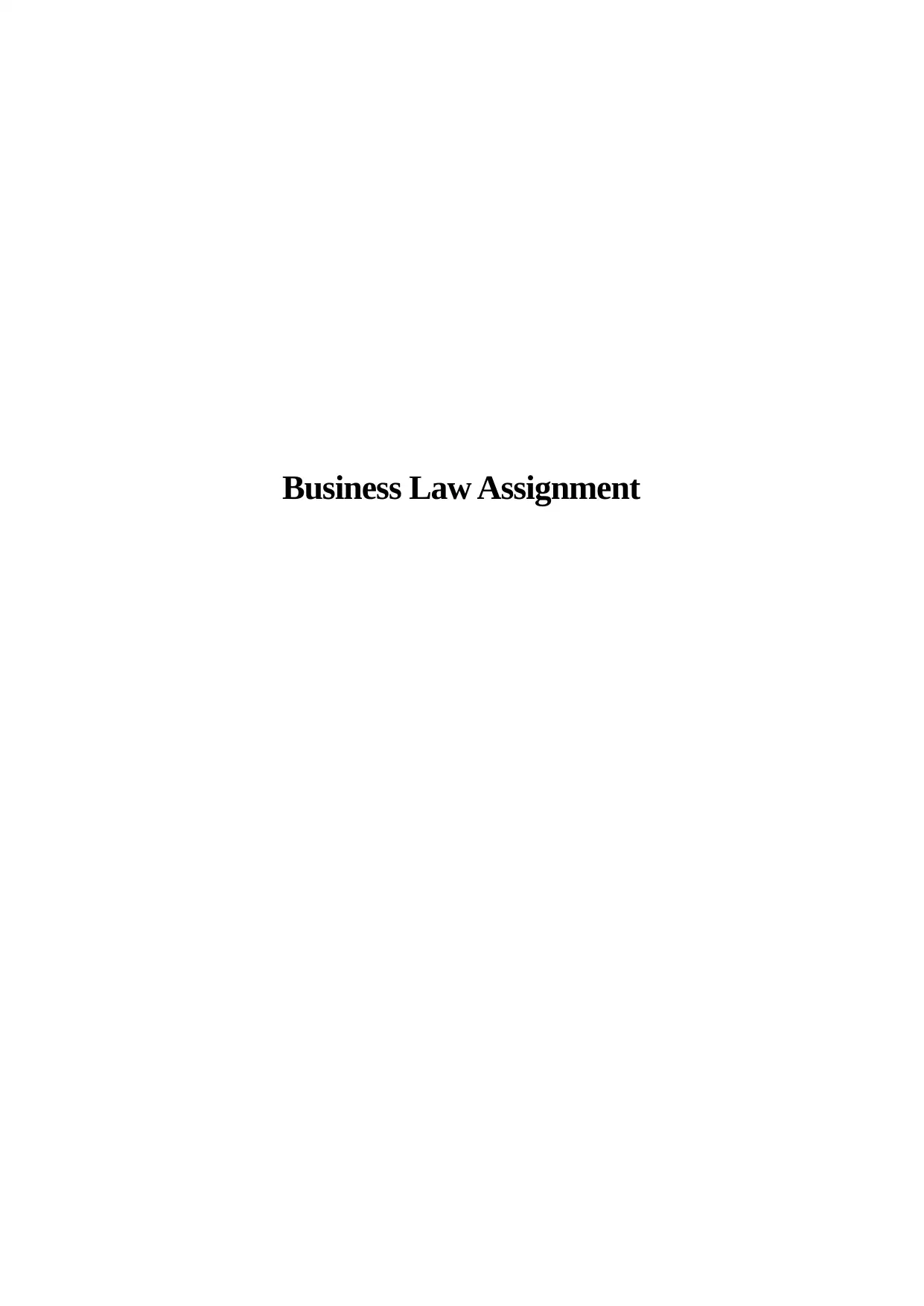
Business Law Assignment
Paraphrase This Document
Need a fresh take? Get an instant paraphrase of this document with our AI Paraphraser

Table of Contents
Question 1..................................................................................................................................3
Question 2..................................................................................................................................5
Question 3..................................................................................................................................7
Question 4..................................................................................................................................9
Question 5................................................................................................................................12
References................................................................................................................................17
Question 1..................................................................................................................................3
Question 2..................................................................................................................................5
Question 3..................................................................................................................................7
Question 4..................................................................................................................................9
Question 5................................................................................................................................12
References................................................................................................................................17
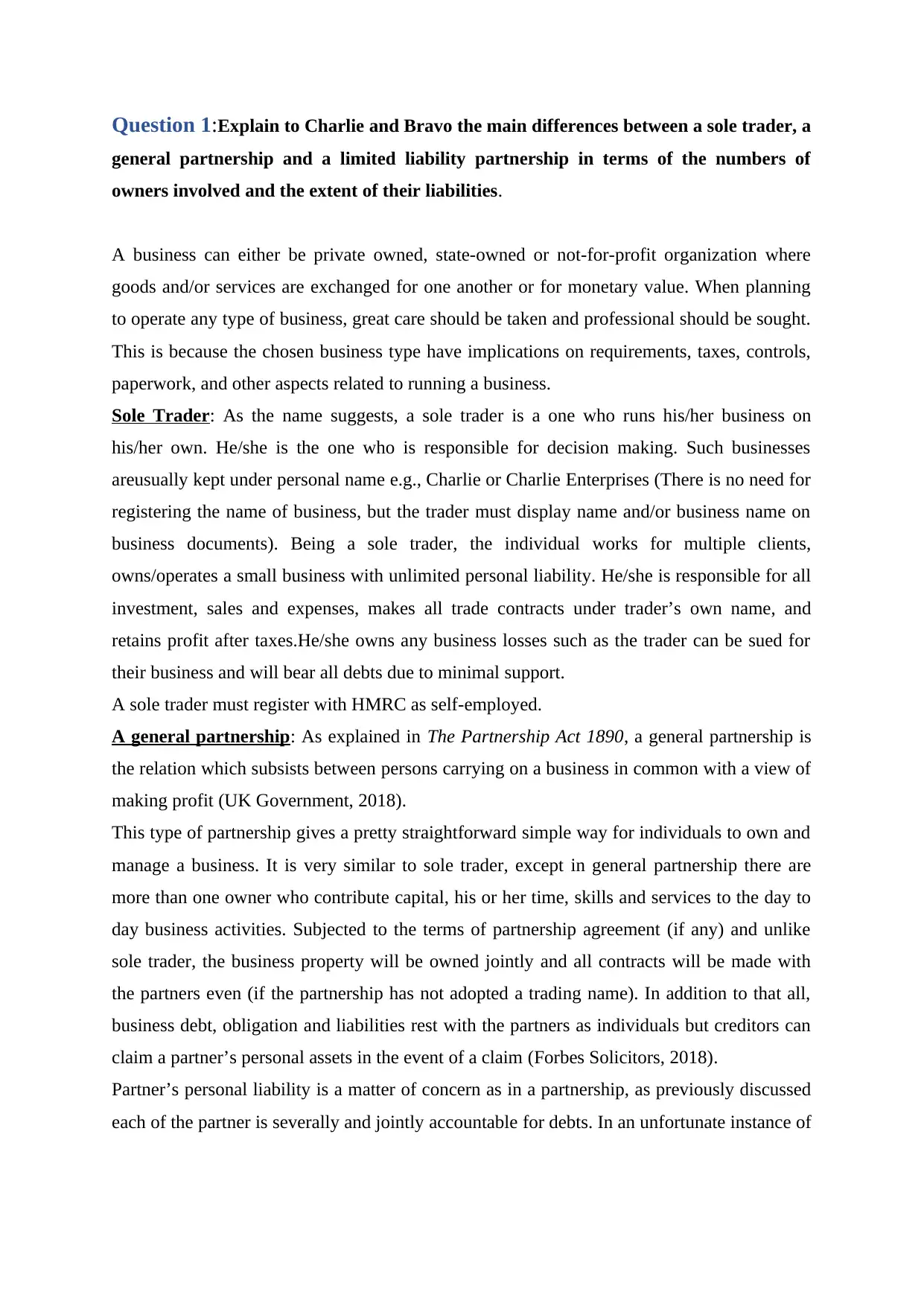
Question 1:Explain to Charlie and Bravo the main differences between a sole trader, a
general partnership and a limited liability partnership in terms of the numbers of
owners involved and the extent of their liabilities.
A business can either be private owned, state-owned or not-for-profit organization where
goods and/or services are exchanged for one another or for monetary value. When planning
to operate any type of business, great care should be taken and professional should be sought.
This is because the chosen business type have implications on requirements, taxes, controls,
paperwork, and other aspects related to running a business.
Sole Trader: As the name suggests, a sole trader is a one who runs his/her business on
his/her own. He/she is the one who is responsible for decision making. Such businesses
areusually kept under personal name e.g., Charlie or Charlie Enterprises (There is no need for
registering the name of business, but the trader must display name and/or business name on
business documents). Being a sole trader, the individual works for multiple clients,
owns/operates a small business with unlimited personal liability. He/she is responsible for all
investment, sales and expenses, makes all trade contracts under trader’s own name, and
retains profit after taxes.He/she owns any business losses such as the trader can be sued for
their business and will bear all debts due to minimal support.
A sole trader must register with HMRC as self-employed.
A general partnership: As explained in The Partnership Act 1890, a general partnership is
the relation which subsists between persons carrying on a business in common with a view of
making profit (UK Government, 2018).
This type of partnership gives a pretty straightforward simple way for individuals to own and
manage a business. It is very similar to sole trader, except in general partnership there are
more than one owner who contribute capital, his or her time, skills and services to the day to
day business activities. Subjected to the terms of partnership agreement (if any) and unlike
sole trader, the business property will be owned jointly and all contracts will be made with
the partners even (if the partnership has not adopted a trading name). In addition to that all,
business debt, obligation and liabilities rest with the partners as individuals but creditors can
claim a partner’s personal assets in the event of a claim (Forbes Solicitors, 2018).
Partner’s personal liability is a matter of concern as in a partnership, as previously discussed
each of the partner is severally and jointly accountable for debts. In an unfortunate instance of
general partnership and a limited liability partnership in terms of the numbers of
owners involved and the extent of their liabilities.
A business can either be private owned, state-owned or not-for-profit organization where
goods and/or services are exchanged for one another or for monetary value. When planning
to operate any type of business, great care should be taken and professional should be sought.
This is because the chosen business type have implications on requirements, taxes, controls,
paperwork, and other aspects related to running a business.
Sole Trader: As the name suggests, a sole trader is a one who runs his/her business on
his/her own. He/she is the one who is responsible for decision making. Such businesses
areusually kept under personal name e.g., Charlie or Charlie Enterprises (There is no need for
registering the name of business, but the trader must display name and/or business name on
business documents). Being a sole trader, the individual works for multiple clients,
owns/operates a small business with unlimited personal liability. He/she is responsible for all
investment, sales and expenses, makes all trade contracts under trader’s own name, and
retains profit after taxes.He/she owns any business losses such as the trader can be sued for
their business and will bear all debts due to minimal support.
A sole trader must register with HMRC as self-employed.
A general partnership: As explained in The Partnership Act 1890, a general partnership is
the relation which subsists between persons carrying on a business in common with a view of
making profit (UK Government, 2018).
This type of partnership gives a pretty straightforward simple way for individuals to own and
manage a business. It is very similar to sole trader, except in general partnership there are
more than one owner who contribute capital, his or her time, skills and services to the day to
day business activities. Subjected to the terms of partnership agreement (if any) and unlike
sole trader, the business property will be owned jointly and all contracts will be made with
the partners even (if the partnership has not adopted a trading name). In addition to that all,
business debt, obligation and liabilities rest with the partners as individuals but creditors can
claim a partner’s personal assets in the event of a claim (Forbes Solicitors, 2018).
Partner’s personal liability is a matter of concern as in a partnership, as previously discussed
each of the partner is severally and jointly accountable for debts. In an unfortunate instance of
⊘ This is a preview!⊘
Do you want full access?
Subscribe today to unlock all pages.

Trusted by 1+ million students worldwide
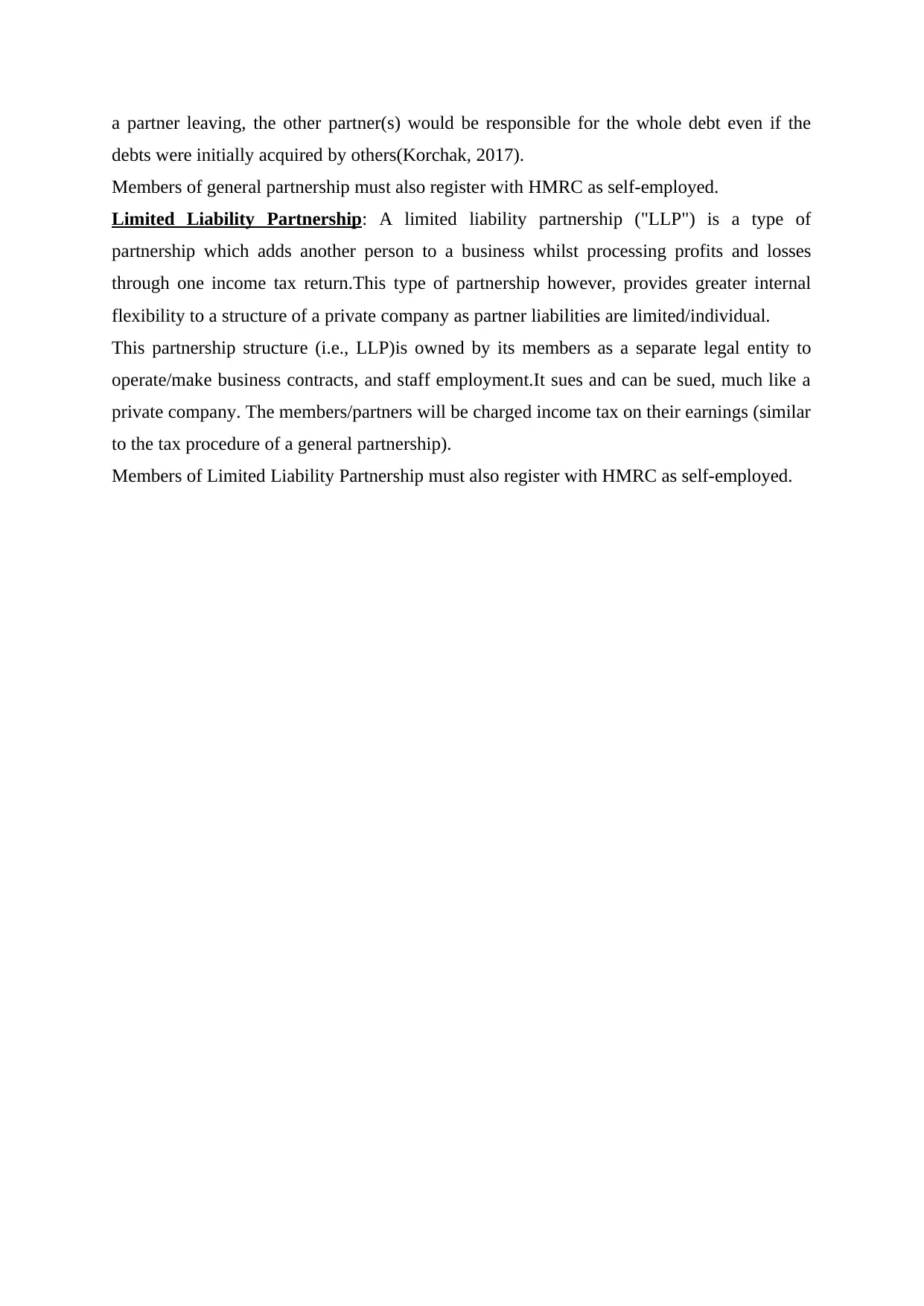
a partner leaving, the other partner(s) would be responsible for the whole debt even if the
debts were initially acquired by others(Korchak, 2017).
Members of general partnership must also register with HMRC as self-employed.
Limited Liability Partnership: A limited liability partnership ("LLP") is a type of
partnership which adds another person to a business whilst processing profits and losses
through one income tax return.This type of partnership however, provides greater internal
flexibility to a structure of a private company as partner liabilities are limited/individual.
This partnership structure (i.e., LLP)is owned by its members as a separate legal entity to
operate/make business contracts, and staff employment.It sues and can be sued, much like a
private company. The members/partners will be charged income tax on their earnings (similar
to the tax procedure of a general partnership).
Members of Limited Liability Partnership must also register with HMRC as self-employed.
debts were initially acquired by others(Korchak, 2017).
Members of general partnership must also register with HMRC as self-employed.
Limited Liability Partnership: A limited liability partnership ("LLP") is a type of
partnership which adds another person to a business whilst processing profits and losses
through one income tax return.This type of partnership however, provides greater internal
flexibility to a structure of a private company as partner liabilities are limited/individual.
This partnership structure (i.e., LLP)is owned by its members as a separate legal entity to
operate/make business contracts, and staff employment.It sues and can be sued, much like a
private company. The members/partners will be charged income tax on their earnings (similar
to the tax procedure of a general partnership).
Members of Limited Liability Partnership must also register with HMRC as self-employed.
Paraphrase This Document
Need a fresh take? Get an instant paraphrase of this document with our AI Paraphraser
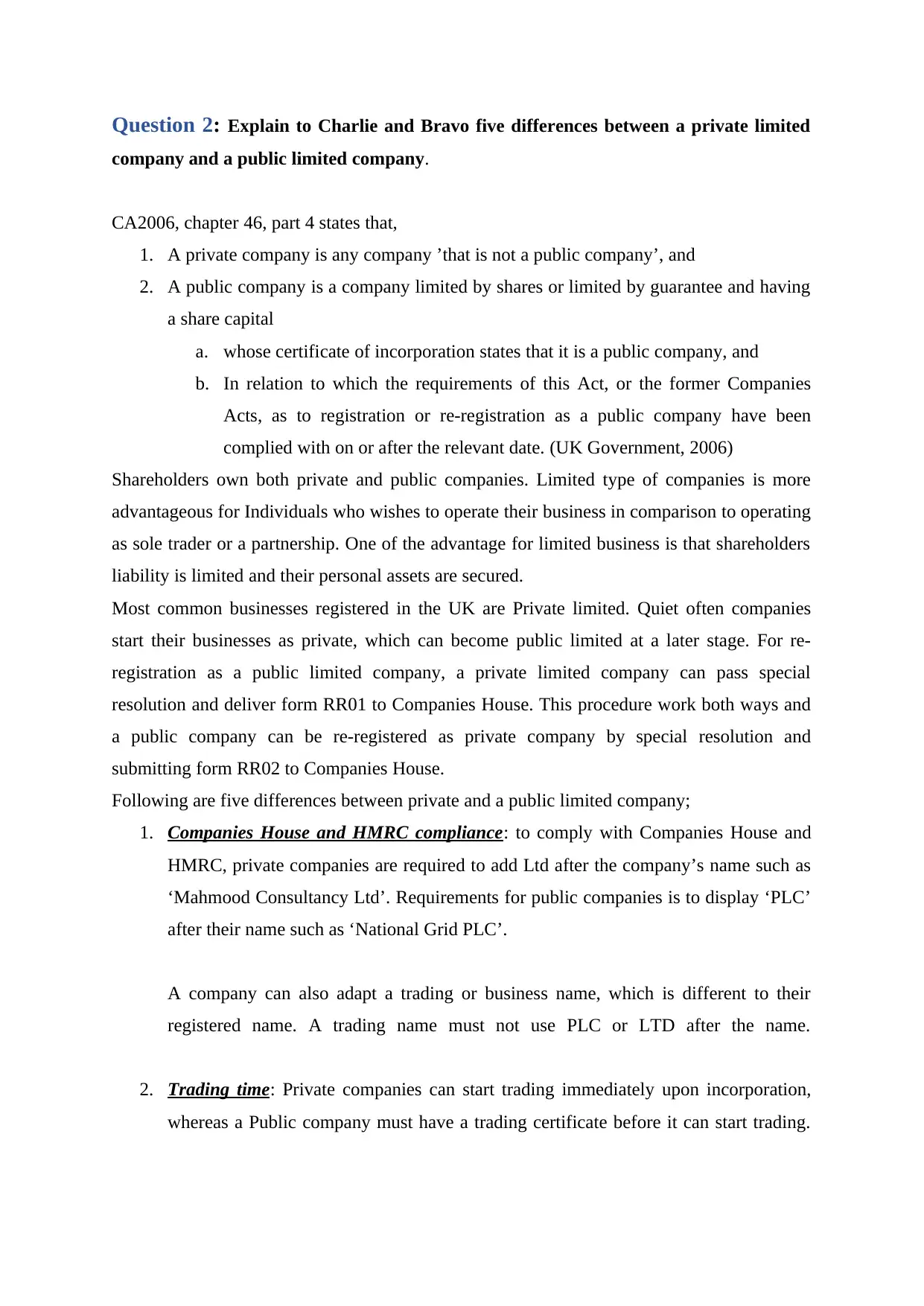
Question 2: Explain to Charlie and Bravo five differences between a private limited
company and a public limited company.
CA2006, chapter 46, part 4 states that,
1. A private company is any company ’that is not a public company’, and
2. A public company is a company limited by shares or limited by guarantee and having
a share capital
a. whose certificate of incorporation states that it is a public company, and
b. In relation to which the requirements of this Act, or the former Companies
Acts, as to registration or re-registration as a public company have been
complied with on or after the relevant date. (UK Government, 2006)
Shareholders own both private and public companies. Limited type of companies is more
advantageous for Individuals who wishes to operate their business in comparison to operating
as sole trader or a partnership. One of the advantage for limited business is that shareholders
liability is limited and their personal assets are secured.
Most common businesses registered in the UK are Private limited. Quiet often companies
start their businesses as private, which can become public limited at a later stage. For re-
registration as a public limited company, a private limited company can pass special
resolution and deliver form RR01 to Companies House. This procedure work both ways and
a public company can be re-registered as private company by special resolution and
submitting form RR02 to Companies House.
Following are five differences between private and a public limited company;
1. Companies House and HMRC compliance: to comply with Companies House and
HMRC, private companies are required to add Ltd after the company’s name such as
‘Mahmood Consultancy Ltd’. Requirements for public companies is to display ‘PLC’
after their name such as ‘National Grid PLC’.
A company can also adapt a trading or business name, which is different to their
registered name. A trading name must not use PLC or LTD after the name.
2. Trading time: Private companies can start trading immediately upon incorporation,
whereas a Public company must have a trading certificate before it can start trading.
company and a public limited company.
CA2006, chapter 46, part 4 states that,
1. A private company is any company ’that is not a public company’, and
2. A public company is a company limited by shares or limited by guarantee and having
a share capital
a. whose certificate of incorporation states that it is a public company, and
b. In relation to which the requirements of this Act, or the former Companies
Acts, as to registration or re-registration as a public company have been
complied with on or after the relevant date. (UK Government, 2006)
Shareholders own both private and public companies. Limited type of companies is more
advantageous for Individuals who wishes to operate their business in comparison to operating
as sole trader or a partnership. One of the advantage for limited business is that shareholders
liability is limited and their personal assets are secured.
Most common businesses registered in the UK are Private limited. Quiet often companies
start their businesses as private, which can become public limited at a later stage. For re-
registration as a public limited company, a private limited company can pass special
resolution and deliver form RR01 to Companies House. This procedure work both ways and
a public company can be re-registered as private company by special resolution and
submitting form RR02 to Companies House.
Following are five differences between private and a public limited company;
1. Companies House and HMRC compliance: to comply with Companies House and
HMRC, private companies are required to add Ltd after the company’s name such as
‘Mahmood Consultancy Ltd’. Requirements for public companies is to display ‘PLC’
after their name such as ‘National Grid PLC’.
A company can also adapt a trading or business name, which is different to their
registered name. A trading name must not use PLC or LTD after the name.
2. Trading time: Private companies can start trading immediately upon incorporation,
whereas a Public company must have a trading certificate before it can start trading.
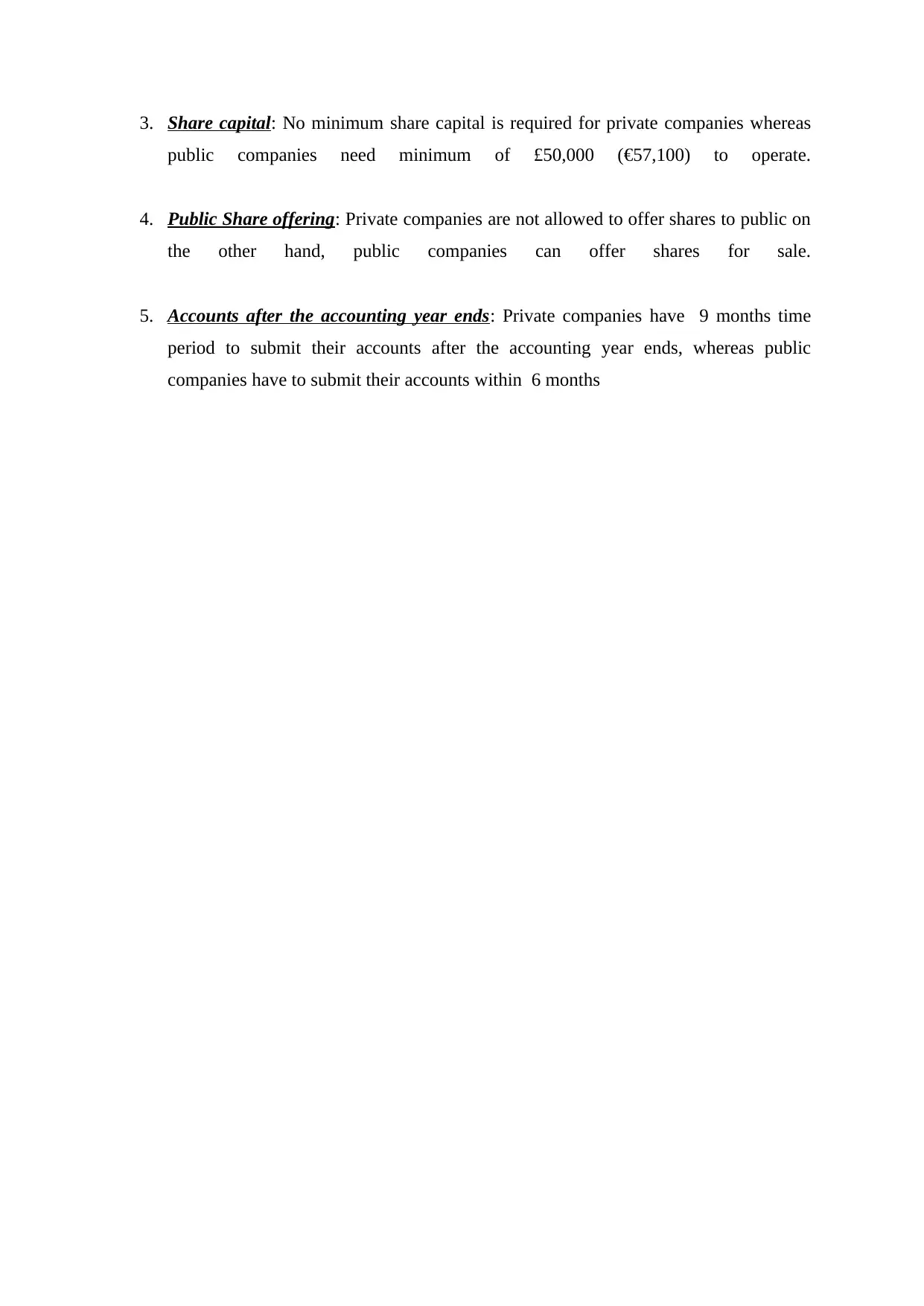
3. Share capital: No minimum share capital is required for private companies whereas
public companies need minimum of £50,000 (€57,100) to operate.
4. Public Share offering: Private companies are not allowed to offer shares to public on
the other hand, public companies can offer shares for sale.
5. Accounts after the accounting year ends: Private companies have 9 months time
period to submit their accounts after the accounting year ends, whereas public
companies have to submit their accounts within 6 months
public companies need minimum of £50,000 (€57,100) to operate.
4. Public Share offering: Private companies are not allowed to offer shares to public on
the other hand, public companies can offer shares for sale.
5. Accounts after the accounting year ends: Private companies have 9 months time
period to submit their accounts after the accounting year ends, whereas public
companies have to submit their accounts within 6 months
⊘ This is a preview!⊘
Do you want full access?
Subscribe today to unlock all pages.

Trusted by 1+ million students worldwide
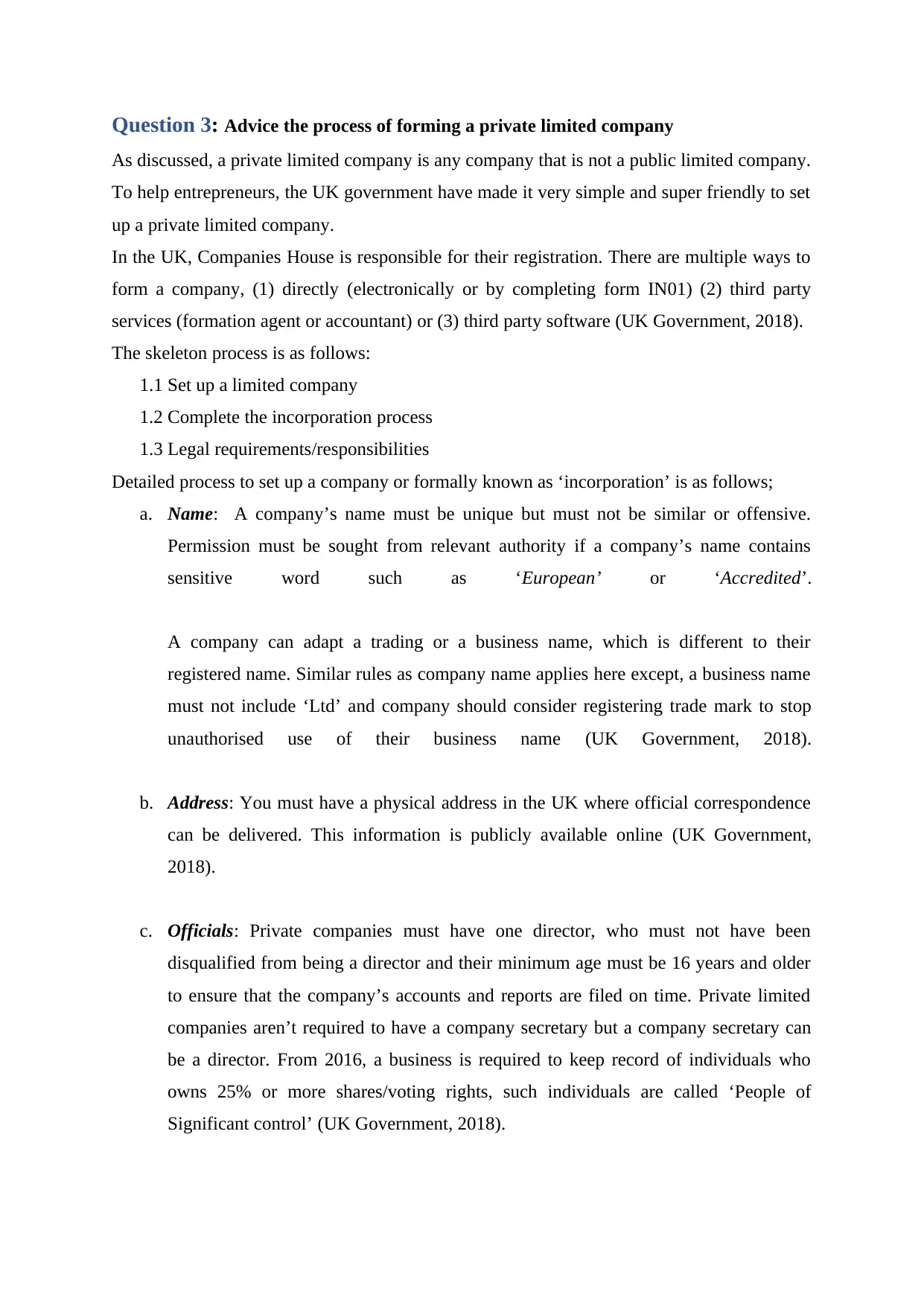
Question 3: Advice the process of forming a private limited company
As discussed, a private limited company is any company that is not a public limited company.
To help entrepreneurs, the UK government have made it very simple and super friendly to set
up a private limited company.
In the UK, Companies House is responsible for their registration. There are multiple ways to
form a company, (1) directly (electronically or by completing form IN01) (2) third party
services (formation agent or accountant) or (3) third party software (UK Government, 2018).
The skeleton process is as follows:
1.1 Set up a limited company
1.2 Complete the incorporation process
1.3 Legal requirements/responsibilities
Detailed process to set up a company or formally known as ‘incorporation’ is as follows;
a. Name: A company’s name must be unique but must not be similar or offensive.
Permission must be sought from relevant authority if a company’s name contains
sensitive word such as ‘European’ or ‘Accredited’.
A company can adapt a trading or a business name, which is different to their
registered name. Similar rules as company name applies here except, a business name
must not include ‘Ltd’ and company should consider registering trade mark to stop
unauthorised use of their business name (UK Government, 2018).
b. Address: You must have a physical address in the UK where official correspondence
can be delivered. This information is publicly available online (UK Government,
2018).
c. Officials: Private companies must have one director, who must not have been
disqualified from being a director and their minimum age must be 16 years and older
to ensure that the company’s accounts and reports are filed on time. Private limited
companies aren’t required to have a company secretary but a company secretary can
be a director. From 2016, a business is required to keep record of individuals who
owns 25% or more shares/voting rights, such individuals are called ‘People of
Significant control’ (UK Government, 2018).
As discussed, a private limited company is any company that is not a public limited company.
To help entrepreneurs, the UK government have made it very simple and super friendly to set
up a private limited company.
In the UK, Companies House is responsible for their registration. There are multiple ways to
form a company, (1) directly (electronically or by completing form IN01) (2) third party
services (formation agent or accountant) or (3) third party software (UK Government, 2018).
The skeleton process is as follows:
1.1 Set up a limited company
1.2 Complete the incorporation process
1.3 Legal requirements/responsibilities
Detailed process to set up a company or formally known as ‘incorporation’ is as follows;
a. Name: A company’s name must be unique but must not be similar or offensive.
Permission must be sought from relevant authority if a company’s name contains
sensitive word such as ‘European’ or ‘Accredited’.
A company can adapt a trading or a business name, which is different to their
registered name. Similar rules as company name applies here except, a business name
must not include ‘Ltd’ and company should consider registering trade mark to stop
unauthorised use of their business name (UK Government, 2018).
b. Address: You must have a physical address in the UK where official correspondence
can be delivered. This information is publicly available online (UK Government,
2018).
c. Officials: Private companies must have one director, who must not have been
disqualified from being a director and their minimum age must be 16 years and older
to ensure that the company’s accounts and reports are filed on time. Private limited
companies aren’t required to have a company secretary but a company secretary can
be a director. From 2016, a business is required to keep record of individuals who
owns 25% or more shares/voting rights, such individuals are called ‘People of
Significant control’ (UK Government, 2018).
Paraphrase This Document
Need a fresh take? Get an instant paraphrase of this document with our AI Paraphraser
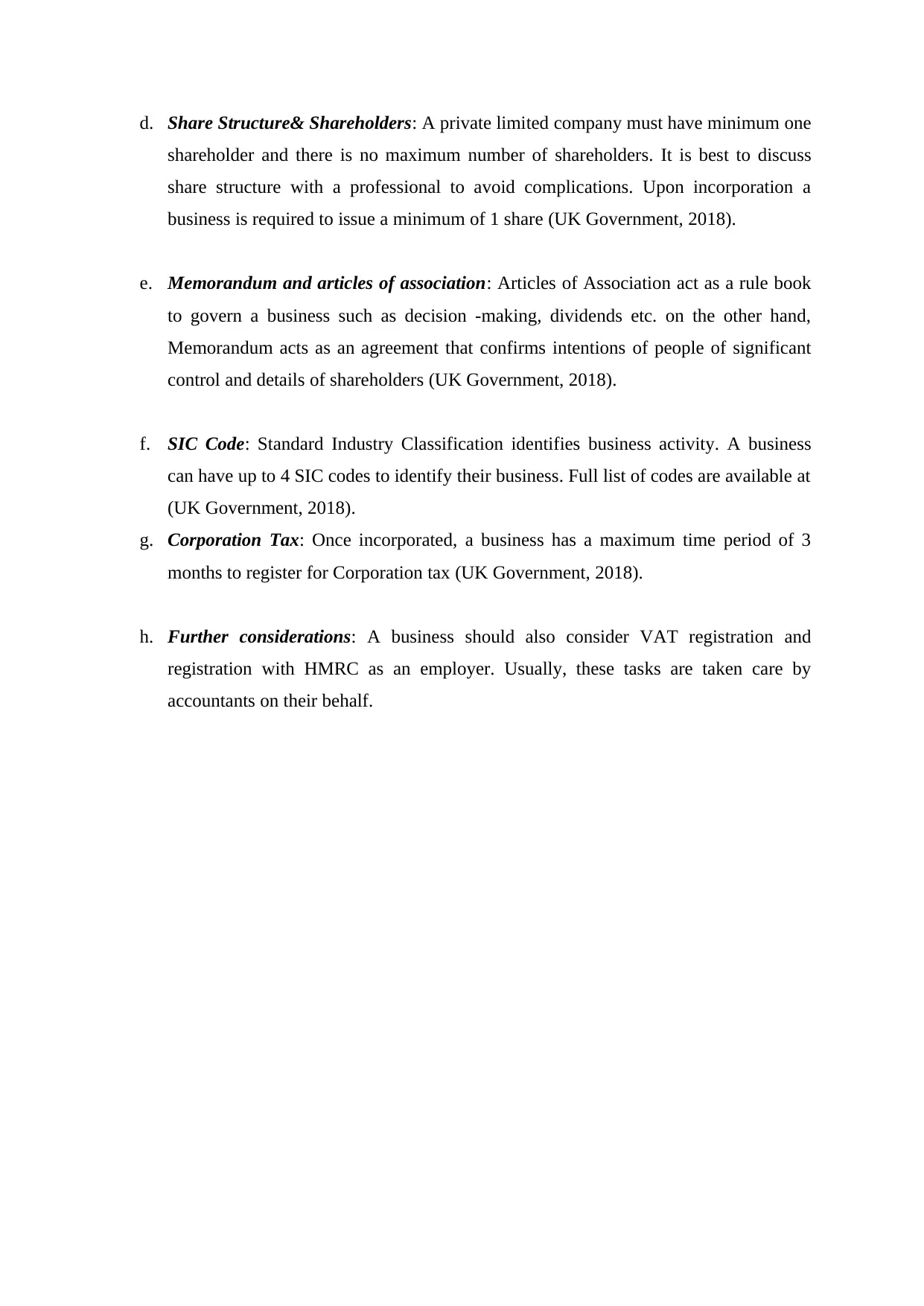
d. Share Structure& Shareholders: A private limited company must have minimum one
shareholder and there is no maximum number of shareholders. It is best to discuss
share structure with a professional to avoid complications. Upon incorporation a
business is required to issue a minimum of 1 share (UK Government, 2018).
e. Memorandum and articles of association: Articles of Association act as a rule book
to govern a business such as decision -making, dividends etc. on the other hand,
Memorandum acts as an agreement that confirms intentions of people of significant
control and details of shareholders (UK Government, 2018).
f. SIC Code: Standard Industry Classification identifies business activity. A business
can have up to 4 SIC codes to identify their business. Full list of codes are available at
(UK Government, 2018).
g. Corporation Tax: Once incorporated, a business has a maximum time period of 3
months to register for Corporation tax (UK Government, 2018).
h. Further considerations: A business should also consider VAT registration and
registration with HMRC as an employer. Usually, these tasks are taken care by
accountants on their behalf.
shareholder and there is no maximum number of shareholders. It is best to discuss
share structure with a professional to avoid complications. Upon incorporation a
business is required to issue a minimum of 1 share (UK Government, 2018).
e. Memorandum and articles of association: Articles of Association act as a rule book
to govern a business such as decision -making, dividends etc. on the other hand,
Memorandum acts as an agreement that confirms intentions of people of significant
control and details of shareholders (UK Government, 2018).
f. SIC Code: Standard Industry Classification identifies business activity. A business
can have up to 4 SIC codes to identify their business. Full list of codes are available at
(UK Government, 2018).
g. Corporation Tax: Once incorporated, a business has a maximum time period of 3
months to register for Corporation tax (UK Government, 2018).
h. Further considerations: A business should also consider VAT registration and
registration with HMRC as an employer. Usually, these tasks are taken care by
accountants on their behalf.
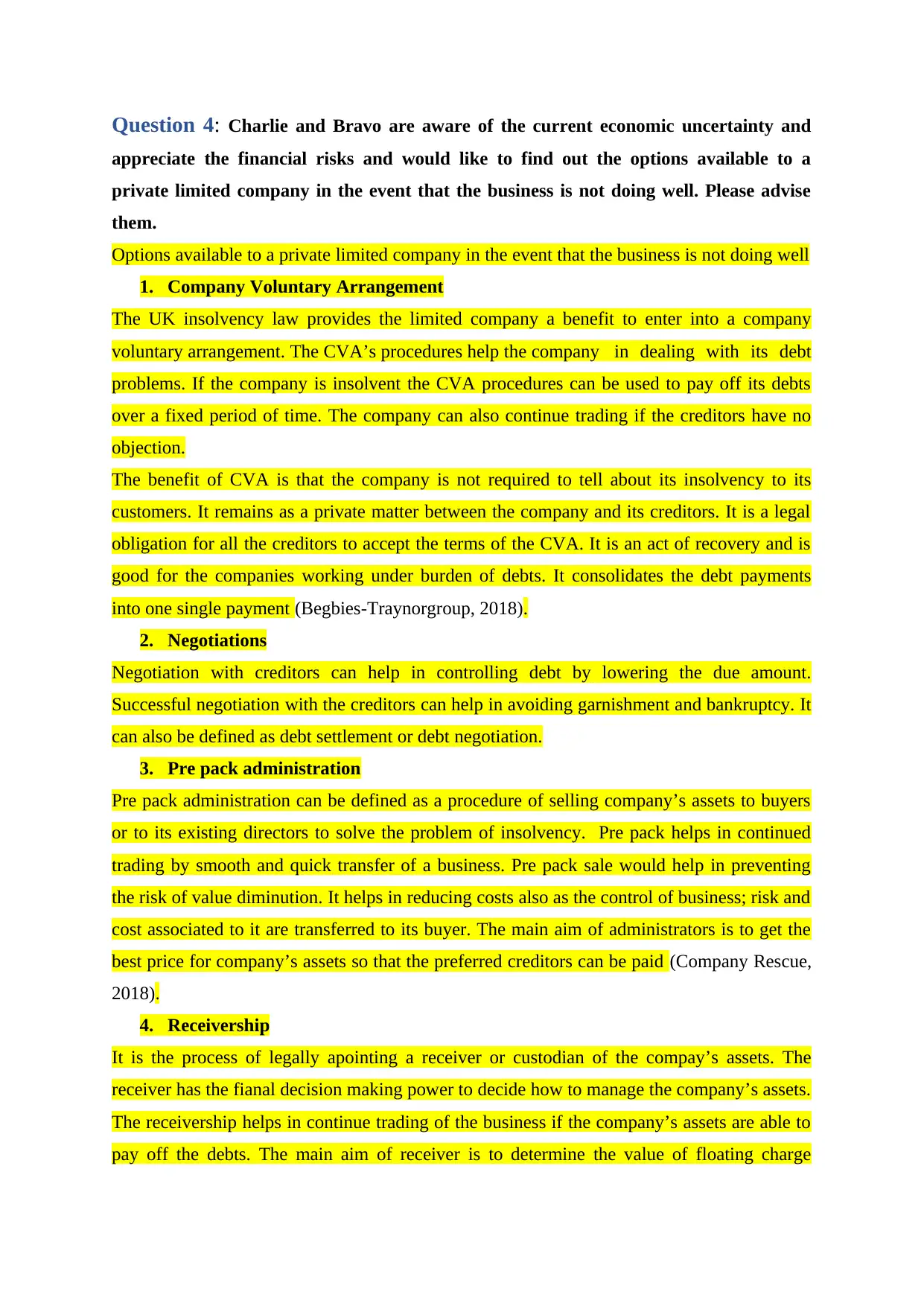
Question 4: Charlie and Bravo are aware of the current economic uncertainty and
appreciate the financial risks and would like to find out the options available to a
private limited company in the event that the business is not doing well. Please advise
them.
Options available to a private limited company in the event that the business is not doing well
1. Company Voluntary Arrangement
The UK insolvency law provides the limited company a benefit to enter into a company
voluntary arrangement. The CVA’s procedures help the company in dealing with its debt
problems. If the company is insolvent the CVA procedures can be used to pay off its debts
over a fixed period of time. The company can also continue trading if the creditors have no
objection.
The benefit of CVA is that the company is not required to tell about its insolvency to its
customers. It remains as a private matter between the company and its creditors. It is a legal
obligation for all the creditors to accept the terms of the CVA. It is an act of recovery and is
good for the companies working under burden of debts. It consolidates the debt payments
into one single payment (Begbies-Traynorgroup, 2018).
2. Negotiations
Negotiation with creditors can help in controlling debt by lowering the due amount.
Successful negotiation with the creditors can help in avoiding garnishment and bankruptcy. It
can also be defined as debt settlement or debt negotiation.
3. Pre pack administration
Pre pack administration can be defined as a procedure of selling company’s assets to buyers
or to its existing directors to solve the problem of insolvency. Pre pack helps in continued
trading by smooth and quick transfer of a business. Pre pack sale would help in preventing
the risk of value diminution. It helps in reducing costs also as the control of business; risk and
cost associated to it are transferred to its buyer. The main aim of administrators is to get the
best price for company’s assets so that the preferred creditors can be paid (Company Rescue,
2018).
4. Receivership
It is the process of legally apointing a receiver or custodian of the compay’s assets. The
receiver has the fianal decision making power to decide how to manage the company’s assets.
The receivership helps in continue trading of the business if the company’s assets are able to
pay off the debts. The main aim of receiver is to determine the value of floating charge
appreciate the financial risks and would like to find out the options available to a
private limited company in the event that the business is not doing well. Please advise
them.
Options available to a private limited company in the event that the business is not doing well
1. Company Voluntary Arrangement
The UK insolvency law provides the limited company a benefit to enter into a company
voluntary arrangement. The CVA’s procedures help the company in dealing with its debt
problems. If the company is insolvent the CVA procedures can be used to pay off its debts
over a fixed period of time. The company can also continue trading if the creditors have no
objection.
The benefit of CVA is that the company is not required to tell about its insolvency to its
customers. It remains as a private matter between the company and its creditors. It is a legal
obligation for all the creditors to accept the terms of the CVA. It is an act of recovery and is
good for the companies working under burden of debts. It consolidates the debt payments
into one single payment (Begbies-Traynorgroup, 2018).
2. Negotiations
Negotiation with creditors can help in controlling debt by lowering the due amount.
Successful negotiation with the creditors can help in avoiding garnishment and bankruptcy. It
can also be defined as debt settlement or debt negotiation.
3. Pre pack administration
Pre pack administration can be defined as a procedure of selling company’s assets to buyers
or to its existing directors to solve the problem of insolvency. Pre pack helps in continued
trading by smooth and quick transfer of a business. Pre pack sale would help in preventing
the risk of value diminution. It helps in reducing costs also as the control of business; risk and
cost associated to it are transferred to its buyer. The main aim of administrators is to get the
best price for company’s assets so that the preferred creditors can be paid (Company Rescue,
2018).
4. Receivership
It is the process of legally apointing a receiver or custodian of the compay’s assets. The
receiver has the fianal decision making power to decide how to manage the company’s assets.
The receivership helps in continue trading of the business if the company’s assets are able to
pay off the debts. The main aim of receiver is to determine the value of floating charge
⊘ This is a preview!⊘
Do you want full access?
Subscribe today to unlock all pages.

Trusted by 1+ million students worldwide
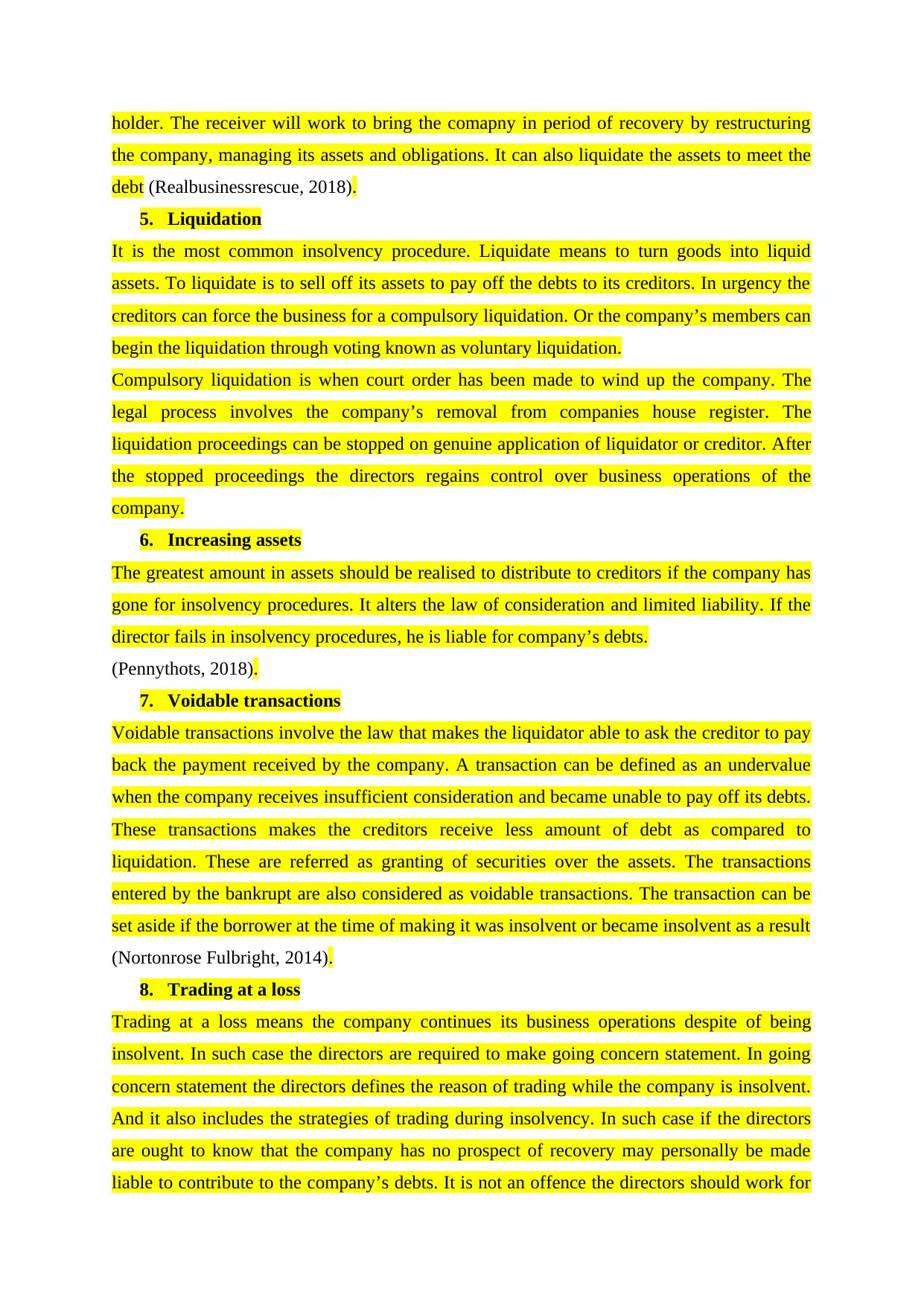
holder. The receiver will work to bring the comapny in period of recovery by restructuring
the company, managing its assets and obligations. It can also liquidate the assets to meet the
debt (Realbusinessrescue, 2018).
5. Liquidation
It is the most common insolvency procedure. Liquidate means to turn goods into liquid
assets. To liquidate is to sell off its assets to pay off the debts to its creditors. In urgency the
creditors can force the business for a compulsory liquidation. Or the company’s members can
begin the liquidation through voting known as voluntary liquidation.
Compulsory liquidation is when court order has been made to wind up the company. The
legal process involves the company’s removal from companies house register. The
liquidation proceedings can be stopped on genuine application of liquidator or creditor. After
the stopped proceedings the directors regains control over business operations of the
company.
6. Increasing assets
The greatest amount in assets should be realised to distribute to creditors if the company has
gone for insolvency procedures. It alters the law of consideration and limited liability. If the
director fails in insolvency procedures, he is liable for company’s debts.
(Pennythots, 2018).
7. Voidable transactions
Voidable transactions involve the law that makes the liquidator able to ask the creditor to pay
back the payment received by the company. A transaction can be defined as an undervalue
when the company receives insufficient consideration and became unable to pay off its debts.
These transactions makes the creditors receive less amount of debt as compared to
liquidation. These are referred as granting of securities over the assets. The transactions
entered by the bankrupt are also considered as voidable transactions. The transaction can be
set aside if the borrower at the time of making it was insolvent or became insolvent as a result
(Nortonrose Fulbright, 2014).
8. Trading at a loss
Trading at a loss means the company continues its business operations despite of being
insolvent. In such case the directors are required to make going concern statement. In going
concern statement the directors defines the reason of trading while the company is insolvent.
And it also includes the strategies of trading during insolvency. In such case if the directors
are ought to know that the company has no prospect of recovery may personally be made
liable to contribute to the company’s debts. It is not an offence the directors should work for
the company, managing its assets and obligations. It can also liquidate the assets to meet the
debt (Realbusinessrescue, 2018).
5. Liquidation
It is the most common insolvency procedure. Liquidate means to turn goods into liquid
assets. To liquidate is to sell off its assets to pay off the debts to its creditors. In urgency the
creditors can force the business for a compulsory liquidation. Or the company’s members can
begin the liquidation through voting known as voluntary liquidation.
Compulsory liquidation is when court order has been made to wind up the company. The
legal process involves the company’s removal from companies house register. The
liquidation proceedings can be stopped on genuine application of liquidator or creditor. After
the stopped proceedings the directors regains control over business operations of the
company.
6. Increasing assets
The greatest amount in assets should be realised to distribute to creditors if the company has
gone for insolvency procedures. It alters the law of consideration and limited liability. If the
director fails in insolvency procedures, he is liable for company’s debts.
(Pennythots, 2018).
7. Voidable transactions
Voidable transactions involve the law that makes the liquidator able to ask the creditor to pay
back the payment received by the company. A transaction can be defined as an undervalue
when the company receives insufficient consideration and became unable to pay off its debts.
These transactions makes the creditors receive less amount of debt as compared to
liquidation. These are referred as granting of securities over the assets. The transactions
entered by the bankrupt are also considered as voidable transactions. The transaction can be
set aside if the borrower at the time of making it was insolvent or became insolvent as a result
(Nortonrose Fulbright, 2014).
8. Trading at a loss
Trading at a loss means the company continues its business operations despite of being
insolvent. In such case the directors are required to make going concern statement. In going
concern statement the directors defines the reason of trading while the company is insolvent.
And it also includes the strategies of trading during insolvency. In such case if the directors
are ought to know that the company has no prospect of recovery may personally be made
liable to contribute to the company’s debts. It is not an offence the directors should work for
Paraphrase This Document
Need a fresh take? Get an instant paraphrase of this document with our AI Paraphraser
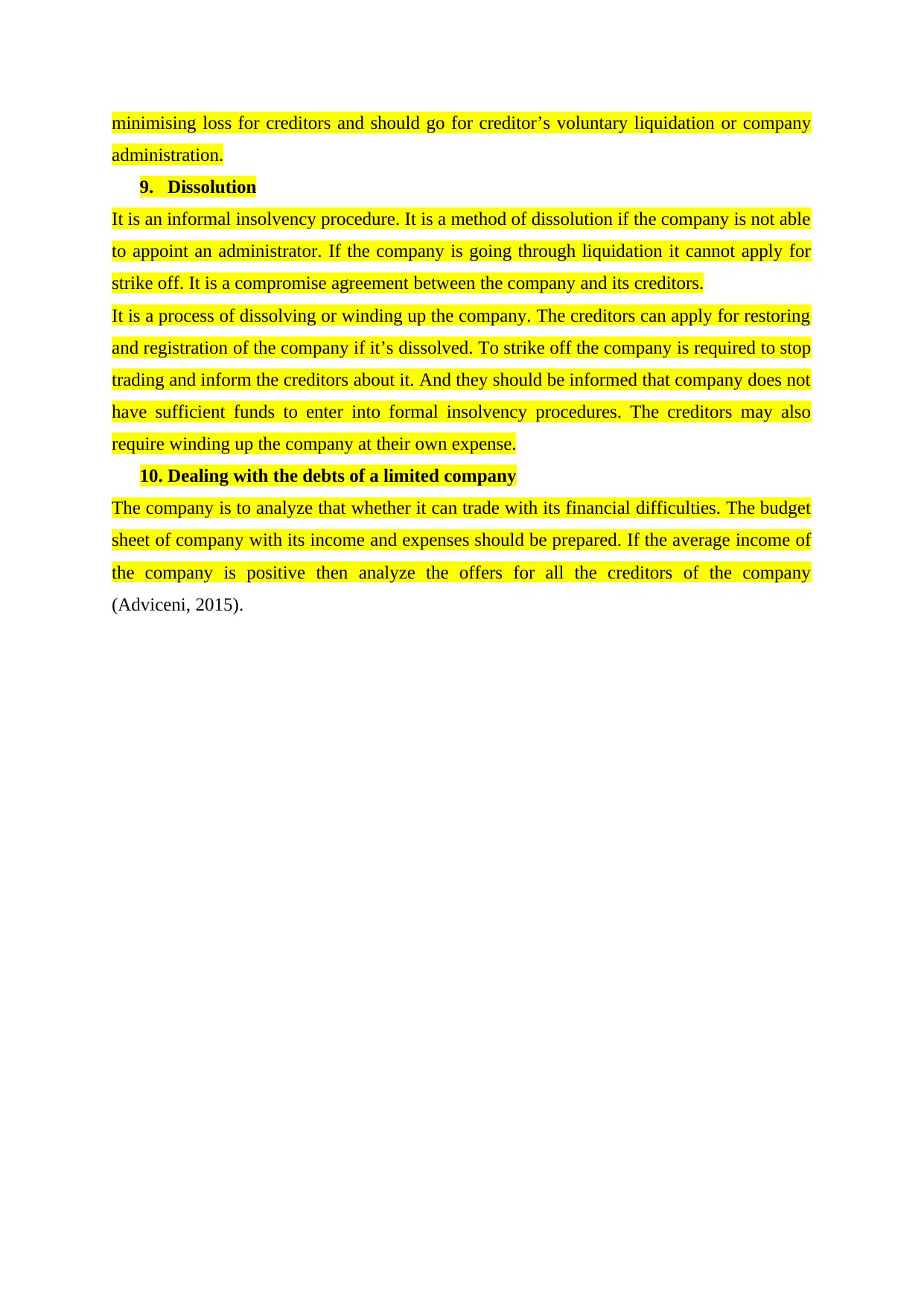
minimising loss for creditors and should go for creditor’s voluntary liquidation or company
administration.
9. Dissolution
It is an informal insolvency procedure. It is a method of dissolution if the company is not able
to appoint an administrator. If the company is going through liquidation it cannot apply for
strike off. It is a compromise agreement between the company and its creditors.
It is a process of dissolving or winding up the company. The creditors can apply for restoring
and registration of the company if it’s dissolved. To strike off the company is required to stop
trading and inform the creditors about it. And they should be informed that company does not
have sufficient funds to enter into formal insolvency procedures. The creditors may also
require winding up the company at their own expense.
10. Dealing with the debts of a limited company
The company is to analyze that whether it can trade with its financial difficulties. The budget
sheet of company with its income and expenses should be prepared. If the average income of
the company is positive then analyze the offers for all the creditors of the company
(Adviceni, 2015).
administration.
9. Dissolution
It is an informal insolvency procedure. It is a method of dissolution if the company is not able
to appoint an administrator. If the company is going through liquidation it cannot apply for
strike off. It is a compromise agreement between the company and its creditors.
It is a process of dissolving or winding up the company. The creditors can apply for restoring
and registration of the company if it’s dissolved. To strike off the company is required to stop
trading and inform the creditors about it. And they should be informed that company does not
have sufficient funds to enter into formal insolvency procedures. The creditors may also
require winding up the company at their own expense.
10. Dealing with the debts of a limited company
The company is to analyze that whether it can trade with its financial difficulties. The budget
sheet of company with its income and expenses should be prepared. If the average income of
the company is positive then analyze the offers for all the creditors of the company
(Adviceni, 2015).
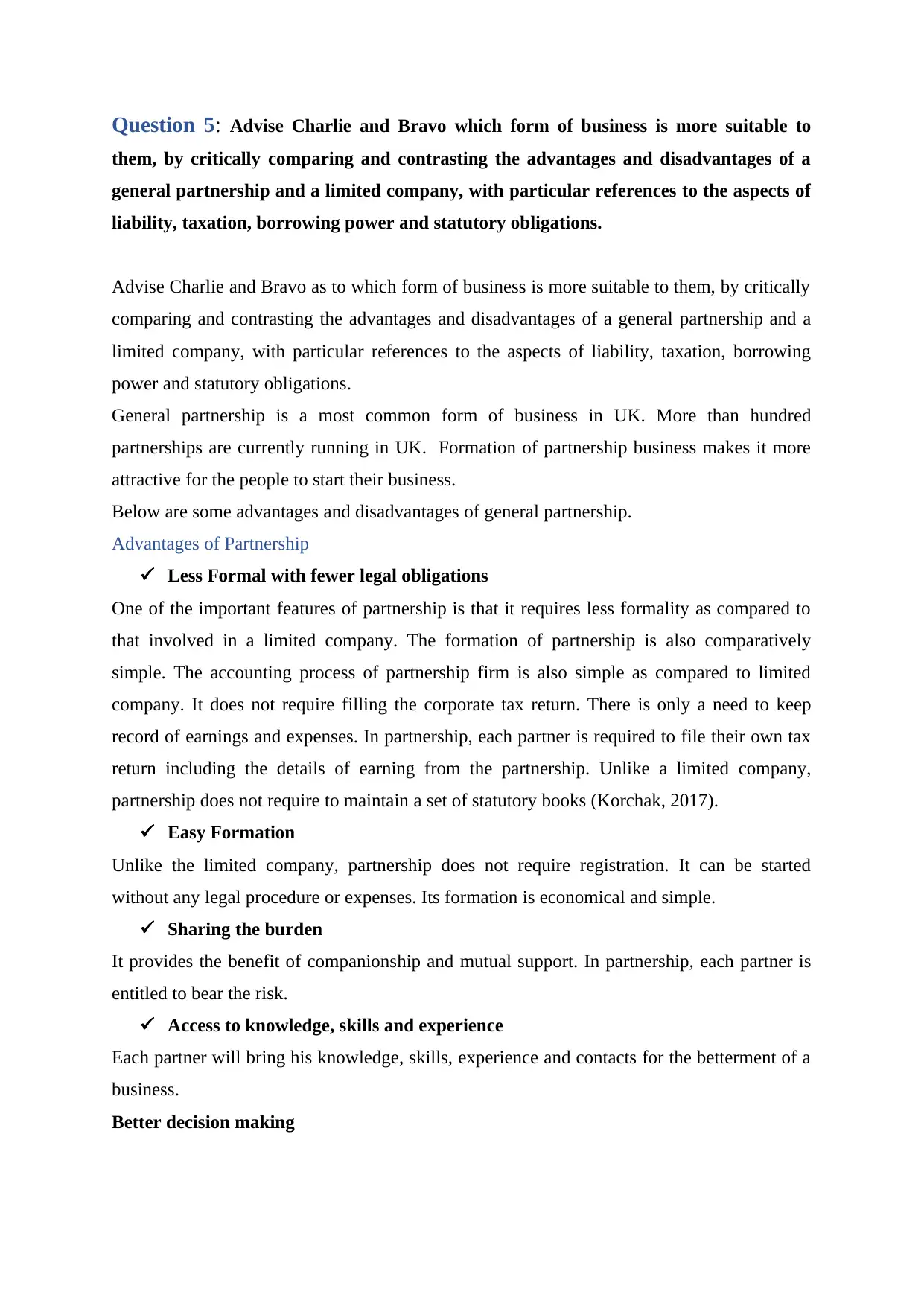
Question 5: Advise Charlie and Bravo which form of business is more suitable to
them, by critically comparing and contrasting the advantages and disadvantages of a
general partnership and a limited company, with particular references to the aspects of
liability, taxation, borrowing power and statutory obligations.
Advise Charlie and Bravo as to which form of business is more suitable to them, by critically
comparing and contrasting the advantages and disadvantages of a general partnership and a
limited company, with particular references to the aspects of liability, taxation, borrowing
power and statutory obligations.
General partnership is a most common form of business in UK. More than hundred
partnerships are currently running in UK. Formation of partnership business makes it more
attractive for the people to start their business.
Below are some advantages and disadvantages of general partnership.
Advantages of Partnership
Less Formal with fewer legal obligations
One of the important features of partnership is that it requires less formality as compared to
that involved in a limited company. The formation of partnership is also comparatively
simple. The accounting process of partnership firm is also simple as compared to limited
company. It does not require filling the corporate tax return. There is only a need to keep
record of earnings and expenses. In partnership, each partner is required to file their own tax
return including the details of earning from the partnership. Unlike a limited company,
partnership does not require to maintain a set of statutory books (Korchak, 2017).
Easy Formation
Unlike the limited company, partnership does not require registration. It can be started
without any legal procedure or expenses. Its formation is economical and simple.
Sharing the burden
It provides the benefit of companionship and mutual support. In partnership, each partner is
entitled to bear the risk.
Access to knowledge, skills and experience
Each partner will bring his knowledge, skills, experience and contacts for the betterment of a
business.
Better decision making
them, by critically comparing and contrasting the advantages and disadvantages of a
general partnership and a limited company, with particular references to the aspects of
liability, taxation, borrowing power and statutory obligations.
Advise Charlie and Bravo as to which form of business is more suitable to them, by critically
comparing and contrasting the advantages and disadvantages of a general partnership and a
limited company, with particular references to the aspects of liability, taxation, borrowing
power and statutory obligations.
General partnership is a most common form of business in UK. More than hundred
partnerships are currently running in UK. Formation of partnership business makes it more
attractive for the people to start their business.
Below are some advantages and disadvantages of general partnership.
Advantages of Partnership
Less Formal with fewer legal obligations
One of the important features of partnership is that it requires less formality as compared to
that involved in a limited company. The formation of partnership is also comparatively
simple. The accounting process of partnership firm is also simple as compared to limited
company. It does not require filling the corporate tax return. There is only a need to keep
record of earnings and expenses. In partnership, each partner is required to file their own tax
return including the details of earning from the partnership. Unlike a limited company,
partnership does not require to maintain a set of statutory books (Korchak, 2017).
Easy Formation
Unlike the limited company, partnership does not require registration. It can be started
without any legal procedure or expenses. Its formation is economical and simple.
Sharing the burden
It provides the benefit of companionship and mutual support. In partnership, each partner is
entitled to bear the risk.
Access to knowledge, skills and experience
Each partner will bring his knowledge, skills, experience and contacts for the betterment of a
business.
Better decision making
⊘ This is a preview!⊘
Do you want full access?
Subscribe today to unlock all pages.

Trusted by 1+ million students worldwide
1 out of 19
Related Documents
Your All-in-One AI-Powered Toolkit for Academic Success.
+13062052269
info@desklib.com
Available 24*7 on WhatsApp / Email
![[object Object]](/_next/static/media/star-bottom.7253800d.svg)
Unlock your academic potential
Copyright © 2020–2025 A2Z Services. All Rights Reserved. Developed and managed by ZUCOL.




